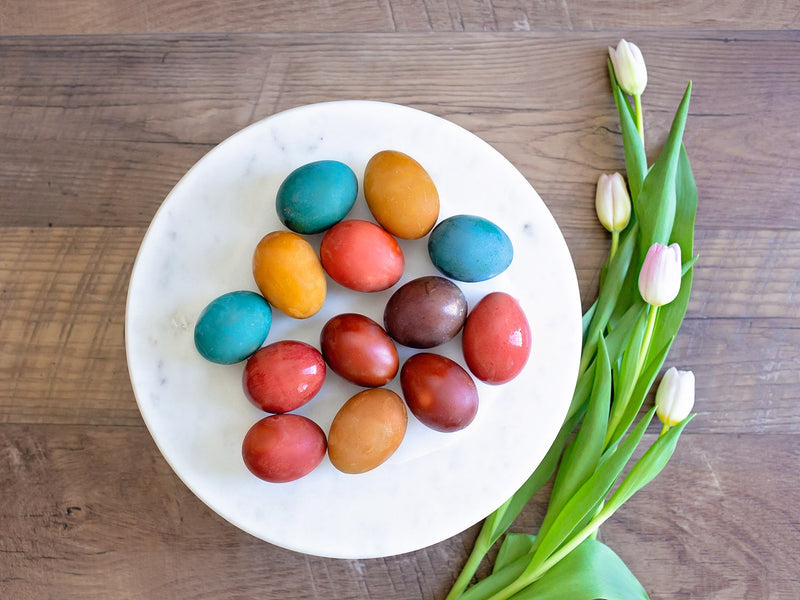
Our guide to Easter eggs - the natural way!
Have you ever wanted to mix up your own egg dyes at home? Have you dreamed of trying your hand at making patterned Easter eggs? Now's your chance! Follow these DIY instructions to create red, orange, yellow, teal, dark brown, blue, and grey egg dyes that look beautiful on naturally brown Nellie's Free Range Eggshells. With so many stunning shades, stripes, and speckle patterns to choose from, you're sure to have the prettiest Easter eggs on the block this year.

Photo Credit: Five Marigolds
What you'll need to make natural egg dye
With just a few things from the grocery store, some tools from your kitchen, and a little creativity, you're on your way to creating beautiful egg dyes in nearly every color of the rainbow! Start by choosing which colors you'd like to make.

Photo Credit: Five Marigolds
Ingredients for each natural dye color
- Red or pink: 2 cups 100% pure beet juice
- Deep orange: 2 cups yellow onion skins
- Golden yellow: 2 tablespoons ground turmeric powder
- Teal: 2 cups chopped red cabbage
- Dark brown: 2 cups peeled red onion skins
- Plum or navy blue: 16 ounces of frozen blueberries
- Shimmery grey: 2 cups 100% pure Concord grape juice
Kitchen tools for making natural dyes
- White vinegar
- Fine strainer (and optional cheesecloth)
- Reusable containers (pint-sized Mason jars work well)
- Medium or large pot (depending on dye batch size)

Photo Credit: Five Marigolds
How to make natural egg dyes
These recipes make enough dye to color 2-3 eggs at once when using pint-sized Mason jars as your dye containers. If you'd like to dye more eggs at once, you can double or triple each recipe and use a larger container or pot to dye a big batch of Easter eggs together — fun for the whole family!
Instructions for juice-based dyes
- Purchase 100% pure juices from your store (you'll need at least 2 cups of juice, and you want to look for ones with no additives!).
- Store juice in the fridge until ready for use.
Instructions for stovetop dyes:
- Place your colorant ingredients (using the amount listed above), 2 cups water (see notes below), and 1 tablespoon white vinegar in a pot. Bring to a boil, turn heat down enough to maintain only a slow rolling boil for 30 minutes with the pot covered (see notes below), keeping the colorant fully submerged in the water throughout the cooking time. If you find your water is boiling below the level of the colorant, add just enough hot water to the pot to keep your colorant submerged through the full cook time.
- Let dye cool, then strain through a fine strainer (lined with a cheesecloth if available).
- Store finished dyes in the refrigerator until they are ready for use.
Please note: the fumes from the turmeric dye can get pretty strong, so we recommend running your stove fan while it boils. For the frozen blueberry dye, use only 1 cup of water instead of two per 16 ounces of blueberries.

Photo Credit: Five Marigolds
How long do natural dyes last?
All dyes should be stored in the refrigerator before and between use. You can also prepare your dyes ahead of time according to the specified shelf-life below:
- Red or pink (beet juice): refer to manufacturer's expiration date
- Deep orange (yellow onion skins): dye can be made up to 4 days in advance
- Golden yellow (turmeric): dye can be made up to 7 days in advance
- Teal (cabbage): dye can be made up to 4 days in advance
- Dark brown (red onion skins): dye can be made up to 4 days in advance
- Plum or navy blue (blueberries): dye can be made up to 4 days in advance
- Shimmery grey (grape juice): refer to manufacturer's expiration date
How to make patterned dyed eggs
Before you get creative with patterns and colors, you'll need to hard-boil your eggs. Use your Instant Pot or our tried and true steaming method for perfect hard-boiled eggs every time! Once they're cooked, let your eggs rest in an ice bath for no less than 15 minutes. This will help the dye stick to the shells and ensure that they peel like a dream if you decide to make deviled eggs or enjoy a snack later.
Tools for pattern-making
- Nellie's Free Range Butter, softened or melted (see steps below)
- Craft sponge, kitchen sponge, or paper towel
- Small paint brush
- Rubber bands
- Stickers
- Natural dyes (note: we found the blueberry and yellow onion dyes worked best for patterns)
Instructions for pattern-making
- Dry eggs off once they have cooled completely in the ice bath.
- To create a speckled pattern, dip a craft sponge, kitchen sponge, or crumpled-up paper towel into a small amount of softened butter and gently "splotch" the butter onto the undyed eggshell. Any part of the eggshell with butter on it will resist the dye and remain brown, while the areas around it will turn the color of your dye. You can also smear butter on half the egg for a half-and-half look or drag the sponge around the egg's circumference to create stripes.
- To create speckles with a paintbrush, melt 1-2 tablespoons of butter in a small dish. Dip your paintbrush into the melted butter and gently tap the brush against your finger above the undyed egg, splattering the butter onto the shell. This technique works best with cold eggs, which helps the butter set right when it touches the shell.
- To create patterns with rubber bands, gently stretch rubber bands around cooled and dried undyed eggs.
- To create patterns with stickers, gently press stickers onto the cooled and dried eggs.
- Once your eggs have been decorated with butter, rubber bands, or stickers, dye them according to the instructions below.
- Once eggs have fully dried after dyeing, gently rinse off any remaining butter under warm running water. Once you've adorned your hard-boiled eggs with butter, rubber bands, and stickers, it's time to add some color and watch your patterns come to life!
Tools for egg dyeing
- Nellie's Free Range Eggs, hard-boiled and chilled in an ice bath
- Chilled natural egg dyes (prepared ahead of time)
- Tall, skinny containers (we found pint-sized Mason jars work well)
- Large spoon, preferably slotted
- Paper towels or dish rags
- Wire cooling rack
Instructions for egg dyeing
- Line your dye containers up on the counter with paper towels or dish rags underneath them to catch any drips when removing the eggs.
- Using a large spoon, gently lower your desired number of eggs into the dye, ensuring that the whole shell is fully submerged.
- Allow the eggs to remain in the dye until your desired color level is achieved
- When your eggs have reached the desired color, use the spoon to remove the eggs from the dye containers. Gently blot the eggs dry with paper towels and set them on the cooling rack to dry completely.
- To store finished eggs, place them on a plate lined with paper towels. Eggs should be consumed within one week (please just be aware that natural dyes have a tendency to peel or change color over time).
How long does it take to dye eggs?
The dyeing process can range from 30 minutes to overnight, but we found that the following times worked best. Please note: If you are dyeing any eggs for more than 2 hours or overnight, store them in the dye in the refrigerator at room temperature.
- Red or pink (beet juice): 1 hour 30 minutes
- Deep orange (yellow onion skins): 2 hours
- Golden yellow (turmeric): 1 hour 30 minutes
- Teal (red cabbage): 2 hours (note: this dye tends to change color after drying for a bit)
- Dark brown (red onion skins): 2 hours
- Plum or navy blue (frozen blueberries): 15-30 minutes for violet blue, overnight for deep navy blue
- Shimmery grey-blue (100% Concord grape juice): 1 hour 30 minutes
Nellie's tips for best results
- It's helpful to check your eggs every 30 minutes or so to see how they're progressing in the dye to ensure you catch them when they're at your favorite tone of each color.
- If you see any bubbling on the surface of the eggs as they're sitting in the dye, don't worry! This means that the acidity of your dye is beginning to break down the eggshell, which is common when using these types of dyes. Just remove the egg from the dye to keep the shell's surface from peeling.
- If you find your eggshells have already started to peel, it's no big deal! Simply rinse it off in cold water, then re-dye the egg (you'll actually find that with a lighter starting base, your final color will be more vibrant). This may occur for certain colors more than others, depending on the acidity of your particular fruit, vegetables, or juices.
- If possible, prepare all your eggs (hard-boiling and cooling) and dye them on the same day for the best results. To help move things along, you can prepare the dyes ahead of time according to the timelines suggested above.
- Natural egg dyes do tend to fade quickly, especially when the finished eggs are kept in the refrigerator so they're still safe to eat. To ensure they maintain their vibrant color, we recommend dyeing them the day before or the day of Easter Sunday.
- If you aren't interested in eating your dyed eggs, you can seal the colors in by spraying the finished eggs with a glossy or matte acrylic craft varnish.

Photo Credit: Five Marigolds









